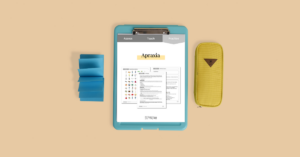In this blog post, Rachel at SLP Now discusses how to use SLP Now’s Goal Bank to write your IEPs!
As a speech-language pathologist, the SLP Now Goal Bank is an awesome resource to have in your toolbox 🧰
How do we use the speech goal targets in the SLP Now Goal Bank to write goals for IEPs that are specific to our students? In this article, I am going to review the types of speech goals included in the SLP Now Goal Bank, and how you can use it to write your students’ speech IEP goals! 👏
What Types of Goals Are Included in the SLP Now Goal Bank?
We have 14 speech and language goal areas for you to explore in the SLP Now Goal Bank 👇
▸ AAC Goals
▸ Articulation Goals
▸ Critical Thinking Goals
▸ Fact & Opinion Goals
▸ Functional Communication Goals
▸ Grammar Goals
▸ Narratives Goals
▸ Phonological Awareness Goals
▸ Phonology Goals
▸ Receptive Language Goals
▸ Social Language Goals
▸ Summarizing Goals
Write SMART Goals to Help Make Your IEP Goals as Clear as Possible
Before we get into choosing targets for our speech and language goals, let’s start with a refresher on how to write SMART goals.
SMART Goals are:
S – Specific: Is your speech goal specific? Did you talk about the setting? Are you putting too many things in one goal?
M – Measurable: Can you measure this speech goal with data? Consider a rubric for some of those harder-to-measure speech therapy goals.
A – Attainable: Is this speech goal attainable in a year for this particular student? Goals are individual, make sure it’s feasible for this student.
R – Realistic: Is this speech goal something that will generalize to the classroom/school environment and help the student succeed at school? Have you considered the whole EBP triangle with research, clinical judgment, and information from the student and their family?
T- Timely: Can the student achieve the speech goal in the amount of service time you are recommending for the IEP?
5 Areas to Consider When Choosing Speech and Language Goal Targets
Student Case History
Understanding a speech student’s case history is a huge part of understanding the whole student. Gaining background on the student’s family history, home environment, and previous medical history is very important.
Teacher Input
If you are a speech-language pathologist in the schools, it is critical that you get teacher input! In most (if not all) states, there must be an area of educational impact to determine a student qualifies for school-based speech services. Speaking with the student’s teacher gives you relevant information on where the student struggles, which in turn helps you determine your goal targets.
Student Input
Have a discussion with your student on what they perceive as their areas of strength and their areas of need.
Student input can have a huge impact on your goal writing process. If there is a speech-related area the student identifies as creating a negative impact on their life (academic or social), this could be an indication that this would be a great speech goal to target (given that it is an area they show a need for).
Student buy-in can really change the game when it comes to making progress toward their goals!
Standardized Speech and Language Assessments
Standardized assessments are a tool to identify how a student compares to other students from similar ages/grades. It also is a resource for us to see specifically which areas the student struggles.
When selecting standardized assessments, keep in mind diagnostic accuracy, reliability, and validity. This is especially important when working with students from different cultures.
Diagnostic Accuracy – how well does a test identify the presence/absence of a disorder?
Reliability – if you repeat a test, will you get the same results?
Validity – does the test measure what it is supposed to?
Informal Speech and Language Assessments
Standardized tests can give us important information, however, informal assessments allow us to get even more! For example, a standardized assessment may only offer a few different items focusing on past-tense verbs, so informal assessments provide us an opportunity to look into that area further.
Examples of Informal Assessments:
Language Samples
Classroom Observations
Work Samples
Putting It All Together – Using SLP Now’s Goal Bank to Write a Speech IEP Goal
So far, we have discussed how to use SLP Now’s Goal Bank to write speech IEPs by looking at goal targets in the SLP Now Goal Bank, areas to consider when writing goals, as well as how to write a SMART goal. Now, let’s practice actually writing the goal keeping this information in mind.
1. Using the formal and informal evaluation information, determine if there is a speech and/or language impairment.
▸ Student exhibited the phonological disorder of fronting /k/ and /g/ during the standardized assessment and informal language sample, and qualifies for speech services.
2. Identify goal targets that impact the student academically/socially.
▸ Parent and teacher report that Student replaces /k/ with /t/ (e.g. “cat” is spelled “tat”) in their spelling. It is also hard to understand what the student is asking or commenting when talking with the teacher and peers in the classroom.
3. Determine which level to target the goal at based on student’s baseline data performance. While determining your student’s baseline for a goal, observe which kind of supports your student benefits from, and, if applicable, include it in your goal!
▸ Student demonstrated the phonological process of fronting in 75% of instances in words. Verbal prompts for tongue placement to produce /k/ increased accuracy.
4. Refer to the SMART goal writing format to ensure that your goal is specific, measurable, attainable, and realistic. If a student produces /k/ with 0% accuracy, it may not be attainable or realistic to mark mastery as 100%.
▸ Based on this information, a SMART goal for Student could be “By the end of the IEP, Student will decrease the phonological process of fronting from 75% to 40% by producing /k/ and /g/ in the initial position of words, given no more than 2 verbal prompts, across 3 consecutive sessions.”
5. Create goal objectives (optional).
▸ When writing goals, it can be useful to create objectives. For example, this goal could have objectives that change the amount of support provided, eventually leading to independence. The first objective could be “given no more than 2 verbal prompts”, and the next objective could be “given no more than 1 verbal prompt.” That way, you are actively tracking data on the parameters set by your objectives during the timeframes they are assigned to.
With an SLP Now membership, the goal bank and objectives are included, making it easy to create goals and track student data!




Reader Interactions